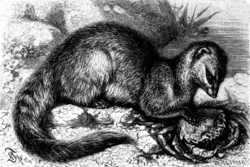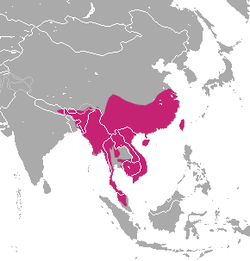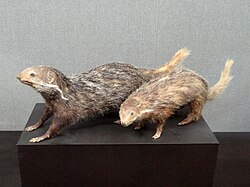Crab-eating mongoose
| Crab-eating mongoose[1] | |
|---|---|

| |
| Conservation status | |
| Scientific classification | |
| Kingdom: | Animalia |
| Phylum: | Chordata |
| Class: | Mammalia |
| Order: | Carnivora |
| Family: | Herpestidae |
| Subfamily: | Herpestinae |
| Genus: | 'Herpestes' |
| Species: | ''H. urva'' |
| Binomial name | |
| Herpestes urva Hodgson, 1836
| |

| |
| Crab-eating mongoose range (green - extant, pink - probably extant) | |
The crab-eating mongoose (Herpestes urva) is a mongoose species ranging from the northeastern Indian subcontinent to Southeast Asia, southern China and Taiwan.
Characteristics
[edit]
H. urva is generally grey in color, with a broad white stripe on its neck extending from its cheeks to its chest. Its throat is steel-gray with white ends of its hair, rendering a salt and pepper appearance. Its hind feet possess hairy soles. Its tail is short and homogeneously colored with a fairer tip. The body of the crab-eating mongoose is 36–52 cm (14–20 in) in length, and 1–2.3 kg (2.2–5.1 lb) in weight.[3]
Distribution and habitat
[edit]Crab-eating mongooses are common in Vietnam, Laos, Cambodia, Thailand, Peninsular Malaysia, northern Myanmar and northeastern India. They are rare in Bangladesh.[2] In Nepal, this species inhabits subtropical evergreen and moist deciduous forests, and has also been observed on agricultural land near human settlements.[4]
Ecology and behaviour
[edit]Crab-eating mongooses are usually active in the mornings and evenings, and were observed in groups of up to four individuals. They are supposed to be good swimmers, and hunt along the banks of streams and close to water.[5]
Despite their common name, their diet consists not only of crabs, but also just about anything else they can catch, including fish, snails, frogs, rodents, birds, reptiles, and insects.[4]
Conservation
[edit]Herpestes urva is listed in CITES Appendix III.[2] It is listed as Least Concern by the IUCN.[2]
References
[edit]- ^ Wozencraft, W. Christopher (16 November 2005). "Order Carnivora (pp. 532-628)". In Wilson, Don E., and Reeder, DeeAnn M., eds (ed.). [http://google.com/books?id=JgAMbNSt8ikC&pg=PA569-70 Mammal Species of the World: A Taxonomic and Geographic Reference] (3rd ed.). Baltimore: Johns Hopkins University Press, 2 vols. (2142 pp.). pp. 569–70. ISBN 978-0-8018-8221-0. OCLC 62265494.
{{cite book}}:|editor=has generic name (help); External link in|title=|ref=harv(help)CS1 maint: multiple names: editors list (link) - ^ Jump up to: a b c d Template:IUCN
- ^ Sheng, H., ed. (2005). Atlas of Mammals of China (in Chinese). Zhengzhou: Henan Science and Technoledge Press. p. 188. ISBN 7-5349-2936-9.
- ^ Jump up to: a b Thapa, S (2013). "Observations of Crab-eating Mongoose Herpestes urva in eastern Nepal" (PDF). Small Carnivore Conservation. 49: 31–3.
- ^ Van Rompaey, H. (2001). The Crab-eating mongoose, Herpestes urva. Small Carnivore Conservation 25: 12–17,
Further reading
[edit]- Menon, V. (2003). A field guide to Indian mammals. Penguin India, New Delhi
External links
[edit]- Pages using duplicate arguments in template calls
- Pages using the JsonConfig extension
- CS1 errors: external links
- CS1 errors: generic name
- CS1 errors: invalid parameter value
- CS1 maint: multiple names: editors list
- CS1 Chinese-language sources (zh)
- IUCN Red List least concern species
- Articles with 'species' microformats
- Taxoboxes with the error color
- Taxobox articles possibly missing a taxonbar
- Mongooses
- Mammals of Bangladesh
- Mammals of Burma
- Mammals of Cambodia
- Mammals of China
- Mammals of India
- Mammals of Laos
- Carnivora of Malaysia
- Mammals of Nepal
- Mammals of Taiwan
- Mammals of Thailand
- Mammals of Vietnam
- Mammals of Southeast Asia

